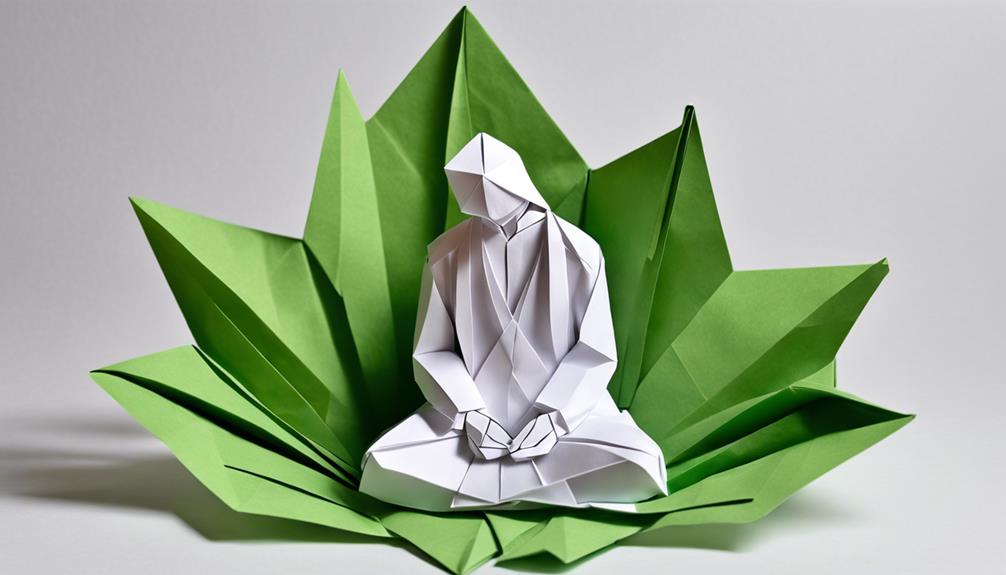To improve your meditation skills, focus on mastering breathing techniques such as diaphragmatic, box, alternate nostril, and 4-7-8 for deep relaxation and energy balance. Calmly acknowledge distractions, redirect your focus to your breath, and embrace these moments without judgment to overcome them. Improve concentration through breath focus, mantra repetition, and consistent daily practice to enhance cognitive function and productivity. To make progress, gradually increase the duration of your meditation sessions, experiment with various techniques, track your progress, seek guidance, and remain committed. Integrate mindfulness into your daily activities to enhance mental clarity and improve stress management. Consider using guided meditations for a more structured practice. Consistency and dedication are essential for long-term benefits.
Key Takeaways
- Master breathing techniques for deep relaxation and focus.
- Create a dedicated, clutter-free meditation space for consistency.
- Explore different meditation styles to find what resonates.
- Practice daily to build focus, resilience, and mental clarity.
- Seek guidance from experienced meditators or teachers for progress.
Benefits of Meditation for Professionals
Enhance your professional performance and well-being by harnessing the benefits of regular meditation. Professionals who incorporate meditation into their routine experience a wide range of advantages that can greatly impact their work life. Research has shown that regular meditation can lead to reduced stress levels, improved emotional intelligence, and increased job satisfaction.
By taking the time to meditate consistently, you can enhance your focus, productivity, and decision-making skills, essential attributes for success in high-pressure environments.
Furthermore, professionals who engage in regular meditation often report better time management, increased creativity, and enhanced problem-solving abilities. This practice not only boosts resilience and adaptability but also contributes to overall mental well-being, helping individuals navigate challenges effectively.
Studies have also indicated that meditation can improve relationships with colleagues, enhance communication skills, and foster a more positive work environment. Embracing meditation as a professional tool can lead to significant improvements in various aspects of your career and personal life.
Setting Up Your Meditation Space
When setting up your meditation space, it's essential to choose a quiet and comfortable area that minimizes distractions.
Creating a designated spot with minimal clutter helps promote a sense of calm and focus during your practice.
Consider adding elements like cushions, candles, or plants to enhance the ambiance and make the space personalized for your meditation journey.
Quiet and Comfortable
Choose a tranquil spot devoid of disturbances to establish your meditation haven. When setting up your meditation space, opt for a quiet area that's free from distractions. This will help you focus your mind and explore deeper into your meditation practice.
Make sure your space is comfortable by adding cushions or a supportive chair to maintain proper posture throughout your session. Good ventilation and lighting are essential for creating a calming atmosphere conducive to meditation. Consider incorporating soothing elements like candles or essential oils to further enhance relaxation.
To promote a sense of peace and mental clarity, keep your meditation area clutter-free. A tidy space can help declutter your mind and allow for a more profound meditation experience.
Personalized Ambiance
To create a personalized ambiance in your meditation space, consider incorporating calming elements like candles, plants, cushions, or soothing music. Choose a quiet and clutter-free area to minimize distractions and promote relaxation. Personalizing your meditation space with these calming elements can help create a tranquil environment conducive to mindfulness.
Natural light or dim lighting can further enhance the soothing atmosphere of your space. Select comfortable seating, such as a cushion or chair, to support your posture during meditation sessions. Keeping your meditation area organized and dedicated solely to your practice can signal your brain that it's time for mindfulness and relaxation.
Breathing Techniques for Deep Meditation
Finally, during deep meditation, mastering various breathing techniques can greatly enhance your practice and promote relaxation and focus.
One effective method is diaphragmatic breathing, where you focus on breathing deeply into your belly. This technique, also known as belly breathing, helps increase oxygen intake, calming the nervous system and aiding in achieving a deeper state of relaxation.
Another beneficial technique is box breathing, involving inhaling, holding, exhaling, and holding the breath in equal counts. This method can be particularly helpful in reducing stress levels during meditation sessions.
Additionally, practicing alternate nostril breathing, or Nadi Shodhana, can help balance the body's energy channels and enhance mental clarity.
Ultimately, the 4-7-8 technique, where you inhale for 4 seconds, hold for 7, and exhale for 8, is effective in calming the mind and promoting a sense of tranquility, making it a valuable tool for deep meditation practices.
Overcoming Distractions in Meditation
When meditating, it's essential to acknowledge distractions without judgment, allowing them to pass through your awareness. By refocusing on your breath or a mantra when distractions arise, you can gently guide your attention back to the present moment.
Remember to practice patience and resilience in dealing with wandering thoughts, accepting them as a normal part of the meditation process.
Focus on Breathing
Anchor your attention during meditation by focusing on your natural breathing pattern. In mindfulness meditation, the breath serves as a constant point of reference, grounding you in the present moment. As you inhale and exhale, observe the sensations of the breath moving through your body. Notice how your chest rises and falls, how the air feels as it enters and exits your nostrils. By centering your awareness on the breath, you create a steady focal point amidst the ebb and flow of distractions.
The rhythm of your breath becomes a powerful tool in managing distractions during meditation. When your mind starts to wander, gently guide your attention back to the sensation of breathing. Use the breath as an anchor, allowing it to draw you back to the present moment.
Embrace distractions as they arise, acknowledging them without judgment. By cultivating a non-reactive attitude towards distractions, you can observe them passing by like clouds in the sky, without losing your focus on the breath. Return to your breath consistently, nurturing your concentration and deepening your mindfulness practice.
Acknowledge Distractions
To enhance your meditation practice, simply observe distractions without judgment, embracing them as opportunities to deepen your mindfulness. Acknowledging distractions during meditation is an important aspect of your practice. By recognizing distractions and allowing them to pass without engaging with them, you develop a non-reactive awareness that strengthens your ability to focus.
Distractions are a natural part of the meditation process, offering you a chance to hone your mindfulness skills. Through this practice, you can cultivate a sense of inner peace and clarity.
Remember that overcoming distractions in meditation requires gentle redirection of your focus back to your breath or chosen anchor. By acknowledging distractions without judgment, you create space for improved focus and a deeper connection to the present moment. This practice of acknowledging distractions is essential for building a strong foundation in meditation and enhancing your overall experience.
Redirect Attention Calmly
Acknowledging distractions in meditation without judgment is essential for maintaining focus and cultivating mindfulness. When distractions arise, it's important to redirect attention calmly and gently guide your focus back to your breath or chosen anchor.
Remember that distractions are normal and part of the meditation process. Consistent practice of redirecting attention calmly is key to maintaining mindfulness and deepening your meditation practice.
Cultivate patience in the process, and understand that it's okay to be distracted; the practice lies in how you bring your focus back.
- Redirect attention calmly to your breath or chosen anchor.
- Practice consistency in gently guiding your focus back.
- Cultivate patience with yourself during the process.
- Understand distractions are normal and part of meditation.
- Deepen your practice by mastering the art of redirecting your attention calmly.
Enhancing Focus and Concentration
Improving your focus and concentration through meditation requires consistent practice and patience. One effective method is focusing on the breath, a key practice in concentration meditation. By directing your attention to the inhalation and exhalation, you develop the ability to anchor your mind in the present moment, enhancing mental clarity and attention span.
Another approach is Mantra meditation, where you repeat a specific word or phrase to cultivate focus. This technique helps quiet the mind and reduce distractions, allowing for a deeper state of concentration.
Research suggests that these meditation practices can improve cognitive function and increase productivity. By training your mind to stay present and focused, you can enhance your ability to concentrate on tasks and maintain attention for longer periods.
Incorporating these techniques into your daily routine can lead to improved focus, sharper concentration, and a greater sense of mental clarity. So, why not give it a try and experience the benefits firsthand?
Progressing in Your Meditation Practice
Consistent practice forms the foundation for advancing in your meditation journey. To progress effectively, consider the following strategies:
- Gradually increase your daily meditation practice: Start with shorter sessions and gradually extend the duration as you become more comfortable with the practice.
- Experiment with different meditation techniques: Try various techniques such as mindfulness meditation, loving-kindness meditation, or body scan meditation to discover what resonates best with you.
- Track your progress: Keep a meditation journal to monitor improvements in your focus, relaxation levels, and overall well-being over time.
- Seek guidance from experienced meditators or teachers: Join meditation classes or workshops, consult with knowledgeable practitioners, or use online resources to deepen your understanding and refine your practice.
- Stay committed to your practice: Consistency is key in meditation. Make it a daily habit to reap the full benefits of this transformative practice.
Integrating Mindfulness Into Daily Life
To enhance your daily life, consider integrating mindfulness into your routine activities for increased presence and focus. Mindfulness can be practiced during simple tasks such as eating, walking, or washing dishes. By staying present in the moment and focusing on your senses, you can cultivate a sense of calm and awareness throughout the day.
Incorporating short meditation sessions into breaks or shifts is another effective way to boost mental clarity and relieve stress. These moments of stillness allow you to reset and approach tasks with a refreshed perspective.
During challenging situations or high-stress moments, mindfulness techniques can help keep you grounded and centered. By acknowledging your thoughts and emotions without judgment, you can navigate difficulties with greater ease. Additionally, practicing gratitude through a journal or meditation can foster a positive mindset and a deeper appreciation for daily experiences.
Mindful listening during conversations is also essential for improving communication skills and fostering meaningful connections with others. By integrating mindfulness into your daily life, you can enhance your overall well-being and presence.
Utilizing Guided Meditations
Consider incorporating guided meditations into your daily routine as a helpful tool for enhancing your meditation practice and deepening your mindfulness experience. Guided meditations provide structured audio instructions that can assist you in staying focused and relaxed during your practice. If you're new to meditation, utilizing guided meditations can be particularly beneficial in establishing a routine and learning different techniques.
Here are five reasons why you should explore guided meditations:
- They offer a structured approach to meditation practice.
- Guided meditations focus on essential elements like breathing and body awareness.
- You can easily access guided meditations through apps, online platforms, or classes.
- They cater to beginners by providing step-by-step instructions.
- Guided meditations come in various themes and styles to suit your preferences and meditation goals.
With guided meditations, you can enhance your mindfulness journey and cultivate a deeper sense of peace and awareness.
Maintaining Consistency and Persistence
For ideal progress in your meditation practice, ensuring regularity and dedication are essential components. Consistency in meditation allows you to access long-term benefits and see tangible progress in your mindfulness journey.
By developing a routine and sticking to it, you strengthen your meditation practice over time, leading to increased focus, mindfulness, and overall well-being. Persistence in meditation is key to revealing deeper layers of your mind and emotions, fostering mental resilience and inner peace.
Next time you sit down to meditate, start building a habit of regular sessions. Dedicate a specific time each day to your practice, creating a sense of discipline and commitment.
Frequently Asked Questions
What Is the Most Efficient Way to Meditate?
To meditate efficiently, focus on quieting your mind, observing thoughts without attachment, and returning to your breath. Cultivate a regular practice, start with short sessions, and gradually increase. Embrace patience and consistency for lasting benefits.
How to Meditate Professionally?
Master meditation by making it a priority in your daily routine. Begin with basic breathing exercises, focus on mindfulness, and gradually increase duration. Practice consistently, embracing patience and persistence to cultivate a professional meditative practice.
How Do I Know if I Am Meditating Correctly?
Notice physical relaxation, mental focus, calmness, clarity, emotional changes, present moment awareness, and tension release during meditation. Evaluate these aspects to determine if you are meditating correctly, ensuring a beneficial practice.
Do and Don'ts During Meditation?
When meditating, do focus on natural breathing like a calm river guiding you. Don't judge sessions; embrace discomfort as growth. Let your breath flow, don't control it. Cultivate awareness of thoughts and emotions to progress deeper.
Can Meditation Help Enhance the Experience of a Wellness Retreat for Singles?
Looking to elevate your self-care journey? Consider attending single friendly wellness retreats for a transformative experience. Meditation can significantly enhance the overall retreat experience, allowing singles to connect with themselves on a deeper level and cultivate a sense of inner peace and mindfulness.
Conclusion
To sum up, meditation can greatly benefit professionals by enhancing focus, reducing stress, and improving overall well-being.
While it may seem challenging at first, with persistence and consistency, you can master the art of meditation like a pro.
Remember, as author Sharon Salzberg once said, 'Meditation is the ultimate mobile device; you can use it anywhere, anytime, unobtrusively.'
So, don't let excuses hold you back from experiencing the transformative power of meditation in your daily life.










